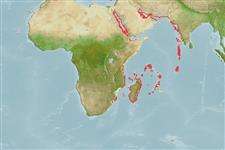Common names from other countries
>
Gobiiformes (Gobies) >
Gobiidae (Gobies) > Gobiinae
Etymology: Trimma: Greek, trimma, -atos = something crushed (Ref. 45335).
Environment: milieu / climate zone / depth range / distribution range
Ecologia
marino associati a barriera corallina; distribuzione batimetrica 2 - 20 m (Ref. 57688). Tropical
Western Indian Ocean: Gulf of Aqaba to the islands of the western Indian Ocean as far south as Tulear, Madagascar; east to the Cargados Carajos shoals north of Mauritius
Size / Peso / Age
Maturity: Lm ? range ? - ? cm
Max length : 4.0 cm TL maschio/sesso non determinato; (Ref. 11344)
Short description
Chiavi di identificazione | Morfologia | Morfometria
This species is distinguished by having the following characters: with a frontal ridge that slopes variably (steeply, and with a ridge, to gradually, without a ridge) into the interorbital trench; postorbital trenches may be steep or shallow sided; posterior nasal opening adnate to eye; second spine of first dorsal fin occasionally elongate, third spine is not; eight or more elements in the second dorsal; fifth pelvic fin ray branched multiple times dichotomously, appearing bushy; 18 or more pectoral rays; scales on head; body color brown-red with five diffuse white vertical bars, between mid-peduncle to just anterior to origin of first dorsal; facial pattern with two white bars under orbit,
and one irregular white bar over vertical limb of the preopercle; a pair of thin fleshy lappets, half a pupil width apart, a quarter pupil width behind the frontal ridge, on either side of dorsal midline of the nape; epibranch of the first gill arch lacks gill rakers (Ref.57688).
Collected over coral reef flats rising above the rubble-sandy bottom (Ref. 57688).
Life cycle and mating behavior
Maturities | Riproduzione | Spawnings | Egg(s) | Fecundities | Larve
Winterbottom, R., 1995. Red Sea gobiid fishes of the genus Trimma, with the description of two new species. Rev. Fr. Aquariol. 22(3-4):93-98. (Ref. 13694)
IUCN Red List Status (Ref. 130435)
CITES (Ref. 128078)
Not Evaluated
Threat to humans
Harmless
Human uses
Strumenti
Special reports
Download XML
Fonti Internet
Estimates based on models
Preferred temperature (Ref.
115969): 24.7 - 29.1, mean 27.5 (based on 537 cells).
Phylogenetic diversity index (Ref.
82804): PD
50 = 0.5000 [Uniqueness, from 0.5 = low to 2.0 = high].
Bayesian length-weight: a=0.01023 (0.00477 - 0.02194), b=3.02 (2.84 - 3.20), in cm Total Length, based on LWR estimates for this (Sub)family-body shape (Ref.
93245).
Resilienza (Ref.
120179): Alto, tempo minimo di raddoppiamento della popolazione meno di 15 mesi (Preliminary K or Fecundity.).
Fishing Vulnerability (Ref.
59153): Low vulnerability (10 of 100).
